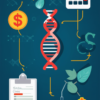
Cord Blood Banking Upgrade Options: Expanding the Possibilities
Exploring the Expanding Possibilities of Cord Blood Banking
Cord blood banking has emerged as a revolutionary practice in the field of regenerative medicine, offering parents the opportunity to preserve their child’s valuable stem cells for potential future use. However, as the industry evolves, so too do the options available to parents seeking to maximize the benefits of cord blood banking. In this article, we will explore the various upgrade options that are transforming the cord blood banking landscape.
Sibling Cord Blood Storage
One of the key advancements in cord blood banking is the ability to store multiple siblings’ cord blood samples within the same account. This option allows families to store the cord blood of subsequent children, ensuring that each child’s unique stem cell profile is preserved and readily available if needed. This is particularly beneficial for families with a history of genetic disorders or those who anticipate the potential need for stem cell therapies in the future.
Expanded Cord Tissue Banking
Traditionally, cord blood banking has been the primary focus, but the industry has now expanded to include cord tissue banking as well. Cord tissue, which contains mesenchymal stem cells, offers additional therapeutic potential and can be used in a variety of regenerative medicine applications. By upgrading to cord tissue banking, families can further diversify their stem cell portfolio and increase the likelihood of finding a suitable match for future treatments.
Upgrade to Private Cord Blood Banking
For families who have previously opted for public cord blood donation, there is now the option to upgrade to private cord blood banking. This allows parents to retain ownership and control over their child’s stem cells, ensuring that they are available for the family’s exclusive use if needed. Private cord blood banking also offers additional benefits, such as the ability to access the sample more easily and the potential for better-quality stem cells compared to public banks.
Combination Cord Blood and Tissue Banking
Some cord blood banking providers now offer the option to store both cord blood and cord tissue within the same account. This comprehensive approach ensures that families have access to a wider range of stem cell types, increasing the likelihood of finding a suitable match for potential future treatments. By combining cord blood and cord tissue banking, parents can future-proof their child’s stem cell portfolio and maintain flexibility in their healthcare choices.
Immune System Expansion Banking
Recent advancements in cord blood banking have led to the introduction of immune system expansion banking. This innovative approach involves using specialized techniques to expand the number of immune cells (T cells and natural killer cells) present in the cord blood sample. This can be particularly beneficial for families with a history of immune-related disorders or for those who anticipate the need for cellular therapies that require a robust immune system.
Extended Storage Periods
As the field of regenerative medicine continues to evolve, the need for long-term storage of cord blood and tissue samples has become increasingly important. Many cord blood banking providers now offer extended storage periods, allowing families to maintain access to their child’s stem cells well into adulthood. This ensures that the samples remain available for potential future treatments, even as medical technology and therapeutic options continue to advance.
By exploring these various upgrade options, parents can tailor their cord blood banking experience to best suit the unique needs of their family. Whether it’s safeguarding against genetic disorders, diversifying their stem cell portfolio, or preparing for the potential advancements in regenerative medicine, these upgrades empower families to take a proactive approach to their child’s healthcare.
Maximizing the Value of Cord Blood: Unlocking Untapped Potential
Unlocking the Untapped Potential of Cord Blood
Cord blood banking has long been recognized as a valuable resource for preserving potentially lifesaving stem cells. However, many people are unaware of the various upgrade options available to maximize the value of their stored cord blood. In this article, we will explore the different ways individuals can enhance their cord blood banking experience and unlock the full potential of this incredible resource.
Expanding Cord Blood Utilization
One of the most significant developments in the cord blood banking industry is the increasing use of cord blood stem cells for a wider range of medical applications. While cord blood was traditionally used primarily for the treatment of blood disorders and cancers, recent advancements in regenerative medicine have opened up a world of new possibilities.
Researchers are now exploring the use of cord blood stem cells in the treatment of neurodegenerative diseases, autoimmune disorders, and even certain types of injuries and tissue damage. This expanded utilization means that the potential value of your stored cord blood may be greater than you initially realized.
Upgrading to Advanced Cord Blood Banking
Many cord blood banking providers now offer advanced storage options that can enhance the long-term viability and usability of your child’s cord blood. One such option is cryogenic storage, which utilizes ultra-low temperatures to preserve the stem cells in a state of suspended animation.
By choosing a cryogenic storage option, you can ensure that your child’s cord blood remains in optimal condition for years or even decades to come. This can be especially important if your child or a family member develops a condition that could be treated with the stored stem cells.
Investing in Cord Blood Banking Research
As the field of regenerative medicine continues to evolve, the potential applications of cord blood stem cells are becoming increasingly diverse. By investing in cord blood banking research, you can play a vital role in unlocking new and innovative ways to utilize this precious resource.
Many cord blood banking providers offer opportunities for families to contribute to ongoing research projects, either through financial contributions or by participating in clinical trials. By supporting these efforts, you can help accelerate the development of new therapies and treatments that could one day save lives.
Exploring Cord Blood Stem Cell Extraction
Another exciting upgrade option is the ability to extract and utilize specific stem cell types from your stored cord blood. While the entire cord blood sample may be stored, some providers now offer the ability to isolate specific stem cell populations, such as mesenchymal stem cells or hematopoietic stem cells.
This level of customization can be particularly valuable if your child or a family member has a specific medical need that could be addressed through the use of a particular stem cell type. By choosing this upgrade, you can ensure that your cord blood is optimized for the most relevant and impactful applications.
Enhancing Accessibility and Usability
Many cord blood banking providers are now offering enhanced accessibility and usability features to make it easier for families to access and utilize their stored cord blood. This can include features such as online portals, mobile apps, and streamlined communication channels that allow you to stay informed about the status of your child’s cord blood and any relevant updates or advancements.
By choosing a cord blood banking provider that prioritizes accessibility and usability, you can ensure that you are well-equipped to make the most of your stored cord blood, should the need ever arise.
The world of cord blood banking is evolving rapidly, and there are numerous upgrade options available to help you maximize the value of your child’s precious stem cells. By exploring these options and investing in the future of regenerative medicine, you can play a vital role in unlocking the untapped potential of cord blood and securing a brighter, healthier tomorrow for your family.
Cutting-Edge Advancements in Cord Blood Preservation and Storage
Unlocking the Potential of Cord Blood: Innovative Preservation and Storage Techniques
In the dynamic landscape of medical advancements, the field of cord blood banking has witnessed a remarkable transformation. As parents increasingly recognize the immense value of preserving their children’s cord blood, the need for cutting-edge preservation and storage techniques has become paramount. This article delves into the latest innovations that are revolutionizing the way we safeguard this precious biological resource.
Cryogenic Preservation: The Gold Standard
Cryogenic preservation has long been the gold standard in cord blood banking, and its importance cannot be overstated. By leveraging the power of ultra-low temperatures, cord blood stem cells can be preserved for decades without losing their potency. Recent advancements in cryogenic technology have further optimized the freezing process, ensuring that the cells remain in a state of suspended animation, ready to be utilized when needed.
Automation and Precision: The Future of Cord Blood Banking
Technological advancements have not only improved the cryogenic preservation process but have also introduced a new era of automation and precision in cord blood banking. Automated processing systems now handle the delicate task of separating and preparing the cord blood samples, reducing the risk of human error and ensuring a consistent level of quality. These cutting-edge systems incorporate advanced algorithms and sensors to monitor every step of the process, guaranteeing the highest standards of purity and viability.
Integrated Tracking and Monitoring
Keeping track of the vast number of cord blood samples stored worldwide has become an increasingly complex challenge. However, the latest developments in cord blood banking have introduced integrated tracking and monitoring systems that revolutionize the way these precious samples are managed. Radio-frequency identification (RFID) technology and cloud-based data platforms allow for real-time monitoring of each sample’s location, temperature, and overall condition, providing parents and medical professionals with unprecedented transparency and peace of mind.
Expansion of Storage Capabilities
As the demand for cord blood banking continues to grow, the industry has responded with a significant expansion of storage capabilities. Cutting-edge facilities now boast larger, state-of-the-art cryogenic storage units that can accommodate significantly more samples, ensuring that families have access to the storage capacity they require. These facilities are also designed with advanced security measures and redundant systems to safeguard the integrity of the stored samples.
Personalized Cord Blood Banking
The evolution of cord blood banking has also led to the emergence of personalized solutions. Families now have the option to choose from a range of storage packages that cater to their specific needs and budgets. This customization allows parents to select the storage duration, sample volume, and even additional services, such as regular sample monitoring and emergency retrieval protocols, ensuring that their child’s cord blood is protected in the most tailored and comprehensive manner.
Streamlined Accessibility
Recognizing the importance of cord blood banking, the industry has made significant strides in improving accessibility. Online platforms and mobile applications now allow parents to seamlessly navigate the cord blood banking process, from initial registration to sample collection and storage. These user-friendly interfaces simplify the entire experience, making it more convenient for families to take advantage of this life-saving resource.
As the world of cord blood banking continues to evolve, these cutting-edge advancements in preservation and storage techniques have opened up a new frontier of possibilities. By leveraging the power of technology and innovation, the industry is ensuring that families can safeguard the future health and well-being of their children with confidence and peace of mind.
The Future of Personalized Medicine: Cord Blood’s Role in Transformative Therapies
Unlocking the Potential of Cord Blood: Emerging Personalized Medicine Therapies
The field of personalized medicine is rapidly evolving, and cord blood banking is playing a crucial role in this transformation. Cord blood, the blood that remains in the umbilical cord and placenta after childbirth, is a valuable source of stem cells that hold immense potential for transformative therapies.
Harnessing the Power of Stem Cells
Cord blood stem cells are unique in their ability to differentiate into a variety of cell types, including blood, bone, and nerve cells. This versatility makes them an invaluable resource for regenerative medicine, where they can be used to treat a wide range of conditions, from genetic disorders to neurological diseases.
Advancing Personalized Treatments
The personalized nature of cord blood banking is a game-changer in the field of medicine. Each individual’s cord blood contains a unique genetic profile, which can be used to tailor treatments to their specific needs. This approach allows healthcare providers to develop targeted therapies that are more effective and have fewer side effects than traditional one-size-fits-all treatments.
Emerging Cord Blood-Derived Therapies
Cord blood-derived therapies are already making significant strides in the treatment of various conditions. For instance, cord blood stem cells have been used in the treatment of certain types of cancer, such as leukemia, by replacing damaged cells with healthy ones. Additionally, these stem cells have shown promise in the management of autoimmune disorders, where they can help regulate the body’s immune response and reduce inflammation.
Unlocking the Potential of Cord Blood-Derived Regenerative Therapies
One of the most exciting areas of cord blood research is in the field of regenerative medicine. Cord blood stem cells have the ability to repair and regenerate damaged tissues, making them a valuable resource for treating conditions like spinal cord injuries, stroke, and neurodegenerative diseases. As research in this area continues to advance, we can expect to see even more innovative therapies emerge that leverage the power of cord blood.
Expanding Cord Blood Banking Options
To further capitalize on the potential of cord blood, parents are now being offered more options when it comes to banking their child’s cord blood. In addition to traditional private cord blood banking, where the cord blood is stored for the family’s exclusive use, there are now public cord blood banks and hybrid models that allow for both private and public storage.
Public Cord Blood Banking: Advancing Research and Accessibility
Public cord blood banks collect and store cord blood donations from families who consent to having their child’s cord blood made available for research and transplantation purposes. This model helps to increase the diversity of the cord blood supply and expand access to these lifesaving therapies for those in need. By contributing to public cord blood banks, families can play a vital role in advancing medical research and improving outcomes for patients worldwide.
Hybrid Cord Blood Banking: The Best of Both Worlds
Hybrid cord blood banking models offer the best of both worlds, allowing families to store a portion of their child’s cord blood for private use while also contributing a portion to a public bank. This approach ensures that the family has access to their own cord blood, while also supporting the broader efforts to expand the pool of available cord blood units for research and transplantation.
As the field of personalized medicine continues to evolve, the role of cord blood banking in transformative therapies is becoming increasingly prominent. By harnessing the power of stem cells and leveraging the unique genetic profiles of cord blood, healthcare providers can develop more targeted and effective treatments that can dramatically improve the lives of patients. With the expanding options for cord blood banking, families now have the opportunity to play a vital role in shaping the future of medicine.
The Evolving Choices in Cord Blood Banking
The world of cord blood banking has undergone significant changes in recent years, offering parents a diverse range of options to consider when preserving their child’s future health. As science and technology continue to advance, the landscape of cord blood banking has evolved, providing families with enhanced opportunities to safeguard their loved ones’ wellbeing.
Exploring Private Cord Blood Banking
Private cord blood banking has long been a popular choice for parents who wish to have exclusive access to their child’s stem cells. This approach allows families to store their baby’s cord blood in a private facility, ensuring it is available for potential future use, should the need arise. With advancements in cryopreservation techniques, private banks now offer enhanced storage solutions, ensuring the long-term viability of the collected stem cells.
The Rise of Hybrid Cord Blood Banking
Recognizing the growing demand for flexible cord blood banking options, some providers have introduced hybrid models that combine the advantages of private and public banking. These hybrid solutions enable parents to store a portion of the collected cord blood for their own family’s use, while the remaining sample is contributed to a public bank, increasing the diversity of the global cord blood inventory. This approach offers families the best of both worlds, providing personal access to their child’s stem cells while also supporting the broader medical research and treatment efforts.
Exploring the Public Cord Blood Banking Option
Public cord blood banks have played a vital role in advancing stem cell research and making these precious resources available to those in need. By donating cord blood to a public bank, families can contribute to a shared pool of stem cells that can be accessed by medical professionals for transplants and other therapies. This altruistic approach has expanded the availability of cord blood for those facing life-threatening conditions, while also contributing to the ongoing scientific exploration of stem cell applications.
Advancements in Cord Blood Processing and Storage
The evolution of cord blood banking has also brought about significant advancements in the processing and storage of these valuable stem cells. Innovative cryopreservation techniques, such as the use of liquid nitrogen storage, have drastically improved the long-term viability of cord blood samples, ensuring that they remain viable for potential future use. Additionally, the development of advanced cell-separation technologies has allowed for the more efficient extraction and preservation of specific stem cell populations, further enhancing the utility of cord blood banking.
Considering the Unique Needs of Your Family
As parents navigate the evolving landscape of cord blood banking, it is essential to carefully evaluate the needs and priorities of their family. Factors such as personal health history, future medical concerns, and financial considerations may all play a role in determining the most suitable cord blood banking option. By engaging in open discussions with healthcare providers and thoroughly researching the available choices, families can make informed decisions that align with their individual goals and values.
The cord blood banking industry has undergone a remarkable transformation, offering families a diverse array of options to safeguard their children’s future health. From private storage solutions to public donation programs, and the emergence of hybrid models, the evolving landscape of cord blood banking provides parents with greater flexibility and control over the preservation of their child’s precious stem cells. By staying informed and considering their unique needs, families can navigate this dynamic field and make the best choice for their loved ones.
Conclusion
As parents navigate the ever-evolving world of cord blood banking, the remarkable advancements in this field have opened up a wealth of new possibilities. From expanding the storage options to unlocking the untapped potential of this valuable biological resource, the future of cord blood banking is poised to transform the landscape of personalized medicine.
The landscape of cord blood banking has seen a remarkable shift in recent years, with a growing emphasis on maximizing the value of this precious biological material. Cutting-edge advancements in preservation and storage techniques have not only extended the viability of cord blood but also enabled the preservation of a broader range of cell types, including mesenchymal stem cells and other specialized cells. This expansion of storage capabilities has far-reaching implications, allowing families to potentially access a wider array of therapeutic applications down the line.
The role of cord blood in the future of personalized medicine cannot be overstated. As researchers and medical professionals continue to unlock the incredible potential of stem cells, the applications of cord blood-derived therapies are becoming increasingly diverse and transformative. From regenerative medicine to targeted treatments for genetic disorders and immune-related conditions, the vast therapeutic possibilities of cord blood are captivating the medical community.
As parents navigate the evolving landscape of cord blood banking, they are faced with an array of choices and considerations. The decision to bank cord blood is a deeply personal one, influenced by individual circumstances, medical history, and future aspirations. By staying informed about the latest advancements and options available, families can make informed decisions that best align with their needs and priorities.
The future of cord blood banking is undoubtedly bright, with the promise of revolutionary therapies and personalized treatments that could dramatically improve quality of life for countless individuals. As research continues to push the boundaries of what is possible, the role of cord blood as a valuable and versatile biological resource will only continue to grow in importance. Parents who choose to bank their child’s cord blood are not only safeguarding a potential lifeline but also contributing to the advancement of medical science and the realization of truly transformative personalized medicine.



















